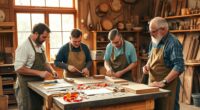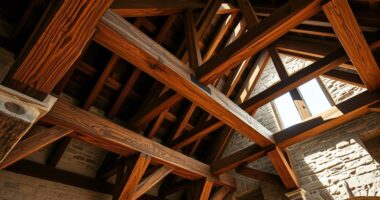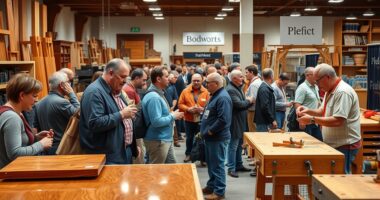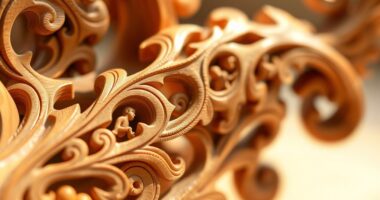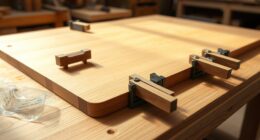Discover the vibrant scene of New Zealand wood artists blending traditional Māori carving with innovative techniques. From iconic pounamu artists like Tamaora Walker to emerging talents like Broxh, these creators incorporate cultural symbols, legends, and modern tools to craft stunning, meaningful works. Some focus on heritage preservation, while others push boundaries with new styles and sustainable practices. Keep exploring to see how these artists honor their roots while shaping the future of Māori art.
Key Takeaways
- Māori carving, or Whakairo, preserves cultural stories and symbols using traditional tools and native woods, highlighting ancestral craftsmanship.
- Renowned artists like Tamaora Walker and Paddy Cooper maintain traditional Māori jade and wood carving practices with cultural significance.
- Contemporary artists such as Broxh innovate by blending traditional Māori motifs with digital platforms and new artistic techniques.
- Modern techniques include layered inlays, laser cutting, pyrography, and sustainable practices using reclaimed or locally sourced wood.
- International collaborations and community workshops help preserve Māori heritage while expanding the global reach of New Zealand wood art.
Celebrated Māori Carving Traditions in New Zealand
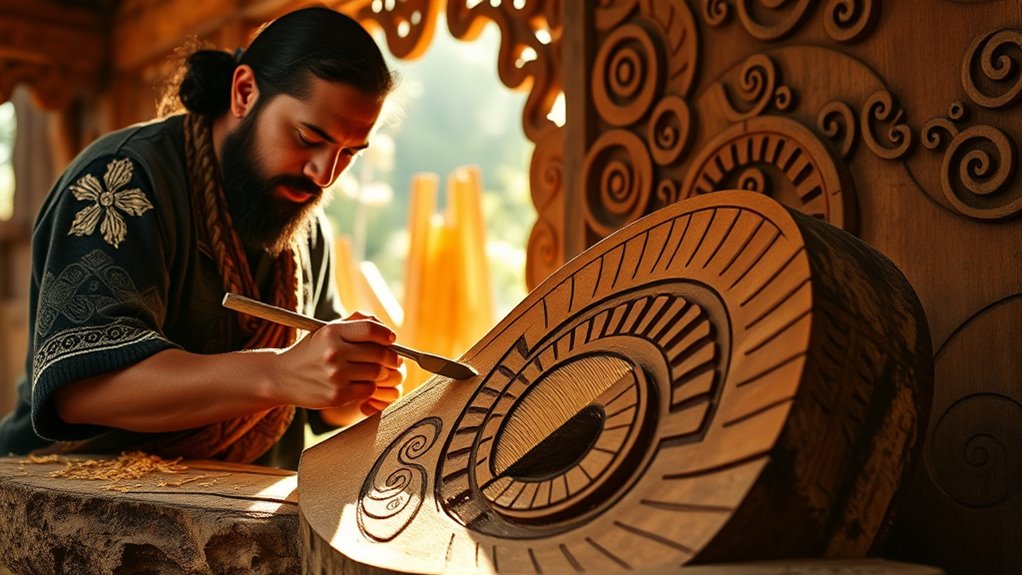
Māori carving, or Whakairo, is a revered art form in New Zealand that embodies the island’s rich cultural heritage. This Māori art involves creating intricate designs on meeting houses, canoes, and personal adornments, each telling stories of ancestors and spiritual beliefs. Skilled carvers like Tamaora Walker and Paddy Cooper preserve ancient techniques, using tools such as adzes and chisels to shape pounamu, bone, and wood into meaningful symbols. Common motifs include spirals, manaia figures, and kowhaiwhai patterns, representing tribal identity, mythology, and natural connections. Māori carving is deeply rooted in community and spiritual practices, often serving ceremonial or protective purposes. Today, contemporary Māori artists honor tradition while blending in modern influences, keeping this sacred art alive for future generations. Additionally, the textile line techniques are sometimes integrated into decorative elements of carvings, showcasing a fusion of different traditional arts.
Renowned Pounamu Artists and Their Cultural Significance

Many renowned pounamu artists, such as Tamaora Walker and Aden Hoglund, draw deeply from Māori heritage to preserve traditional carving practices that hold profound cultural significance. Their work keeps alive the stories, symbols, and spiritual meanings embedded in pounamu. These artists:
- Source rare jade locally, maintaining authenticity and supporting regional craftsmanship.
- Create carvings like hei matau and ceremonial adzes that embody tribal identity and ancestral stories.
- Blend traditional techniques with modern styles, inspired by natural landscapes and organic forms.
- Contribute to the cultural landscape by collaborating across international and family-run studios, like Ernesto Ovalle’s Oro Negro.
- Their dedication to quality and authenticity ensures that each piece preserves the cultural significance of this treasured stone. Additionally, many artists incorporate sustainable practices to protect the environment and ensure the longevity of jade sources for future generations.
Through their artistry, these pounamu creators uphold the spiritual and cultural importance of this treasured stone.
Emerging and Contemporary Wood Artists Shaping the Scene
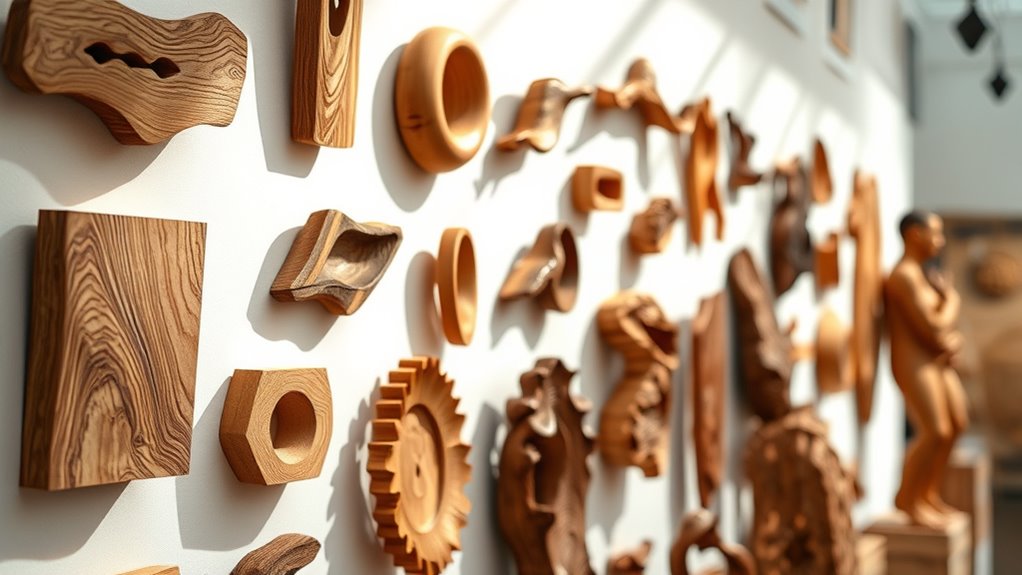
You’ll notice emerging artists like Broxh blending traditional Māori patterns with modern digital platforms, creating fresh ways to share their work. They use classic tools such as adzes and chisels to craft large-scale carvings that honor cultural heritage while exploring new themes. Their innovative styles and digital engagement are transforming New Zealand’s contemporary wood art scene. Additionally, many artists are market smarter, not harder by leveraging social media and online marketing strategies to reach a wider audience and increase their visibility in the competitive art world. Recognizing the importance of alternative investments, some artists are diversifying their income streams by selling online or exploring new mediums to sustain their practice. This adaptability is essential in a competitive art scene, where standing out requires both artistic innovation and savvy business practices. Incorporating financial management strategies, such as budgeting and cash flow control, can help artists ensure their sustainability and growth in this dynamic environment. Moreover, engaging with personal development techniques like goal setting and self-reflection can further enhance their creative and professional success.
Innovative Techniques and Styles
Emerging and contemporary New Zealand wood artists are revolutionizing the scene by blending traditional motifs with cutting-edge techniques and styles. They push creative boundaries through innovative techniques that bring new life to woodwork. They experiment with layered wood inlays and 3D carving, adding depth and texture to their pieces. Many incorporate unconventional materials like metal or resin, creating striking hybrid artworks. Modern power tools complement traditional hand tools, enabling intricate details and large-scale sculptures. Artists utilize advanced finishing processes to enhance visual texture and tactile appeal. Additionally, integrating AI-powered tools helps artists explore new design possibilities and streamline their creative processes. These techniques allow artists to translate New Zealand’s natural landscapes and cultural stories into bold, inventive works that redefine contemporary wood art, fostering a dynamic artistic landscape in the region. Incorporating sustainable practices such as using reclaimed wood further emphasizes their commitment to biodiversity conservation within their creative process.
Cultural Heritage Influence
Contemporary New Zealand wood artists actively draw on Māori carving traditions, infusing their work with cultural symbols and stories that resonate deeply with local heritage. They incorporate traditional motifs, tools like adzes and chisels, and sacred symbols to preserve and promote Māori cultural identity. Many artists reflect regional influences from Rotorua or Tairāwhiti, capturing local landscapes and stories. By blending ancestral techniques with modern aesthetics, they create sculptures and functional objects that honor tradition while innovating creatively. These artists also engage in workshops and community projects, ensuring Māori heritage remains vibrant in the contemporary scene. Their work exemplifies a deep respect for spiritual significance and storytelling through symbolism, reinforcing cultural roots in New Zealand’s evolving wood art landscape. Embracing artistic innovation, they continue to expand the boundaries of traditional Māori carving techniques to appeal to contemporary audiences.
International Influence and Family-Led Studios in New Zealand
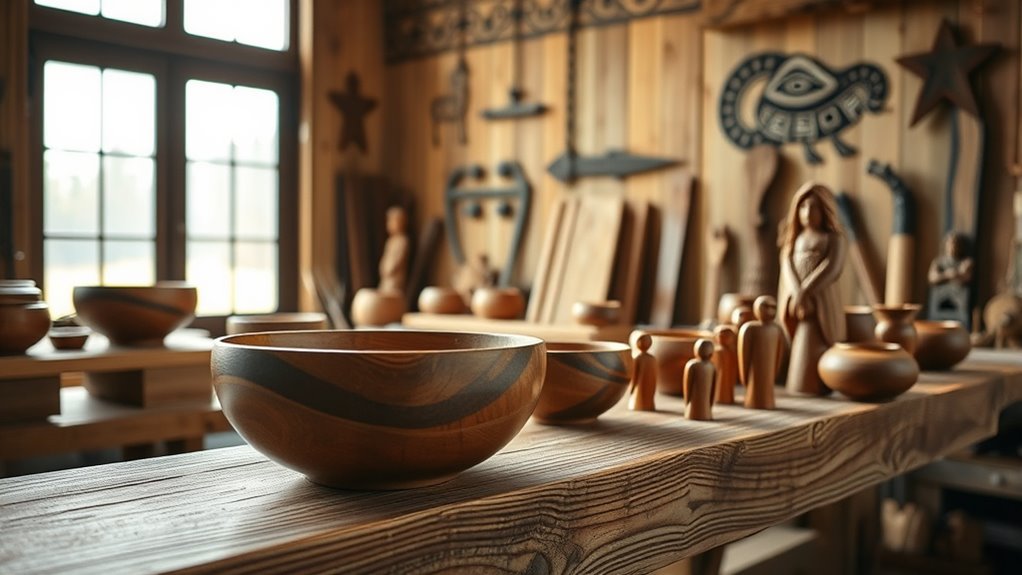
You’ll notice that family-run studios like Ernesto Ovalle’s Oro Negro blend Colombian influences with local craftsmanship, creating unique pieces. International artists such as Ana Krakosky bring fresh perspectives to the native woods and pounamu, enriching the scene. These studios often combine global ideas with Maori traditions, resulting in a vibrant, multicultural craftsmanship landscape. Incorporating traditional craftsmanship techniques helps preserve cultural heritage while fostering innovation. Additionally, the use of sustainable materials in these artworks demonstrates a commitment to environmental responsibility. Moreover, the integration of cultural heritage into contemporary designs ensures the longevity and relevance of these artistic practices.
Family Traditions in Craft
Family traditions play an essential role in shaping New Zealand’s woodcraft scene, with many artisans passing down techniques and stories through generations. You’ll find family-led studios where skills like wood carving become a living legacy, preserving heritage while embracing innovation. For example, Paddy Cooper, a sixth-generation carver, works exclusively with native woods, honoring his ancestors’ craftsmanship. The influence of regional stories and symbols ensures Māori heritage stays vibrant in contemporary work. International influences, like those from Colombian Ernesto Ovalle’s Oro Negro studio, blend global craftsmanship with local Māori and Pākehā traditions. These family traditions create a rich tapestry of cultural storytelling and skill development. They foster a sense of identity, ensuring that New Zealand’s woodcraft remains rooted in legacy and heritage. Additionally, the use of hybrid techniques allows artisans to combine traditional methods with modern tools, enriching the craft and expanding creative possibilities. By integrating innovative methods, artisans can push the boundaries of traditional woodcraft while honoring their cultural roots and sustainable practices. Recognizing the importance of cultural preservation, many artisans actively participate in community workshops and cultural exchanges to keep traditional knowledge alive.
International Artistic Perspectives
International artists have markedly enriched New Zealand’s wood and jade art scenes by bringing diverse cultural influences into local craftsmanship. Artists like Ernesto Ovalle from Colombia and Ana Krakosky have established studios that blend their international backgrounds with Maori and Pākehā traditions. Family-run studios such as Oro Negro, operated by Ovalle and his children, showcase a collaborative approach to jade carving and jewelry. These international and family-led studios introduce global styles, fostering cross-cultural exchange and sparking innovation. Their work emphasizes craftsmanship, heritage, and storytelling, adding new dimensions to New Zealand’s artistic landscape. By integrating international perspectives, these artists expand the creative possibilities within the local scene, enriching the cultural fabric and inspiring contemporary practices across the country’s wood and jade artistry. Additionally, artistic collaboration plays a vital role in blending different techniques and cultural narratives, further enriching New Zealand’s vibrant artistic community. Such collaborations often involve cultural exchange, which enhances the depth and diversity of the artistic expressions present in the region. Embracing technological advancements allows these artists to push creative boundaries and incorporate new mediums into traditional forms, fostering innovation and modernization of the craft. Furthermore, incorporating sustainable materials aligns with New Zealand’s growing emphasis on environmental responsibility in art.
Legacy Carvers and Their Contributions to Heritage
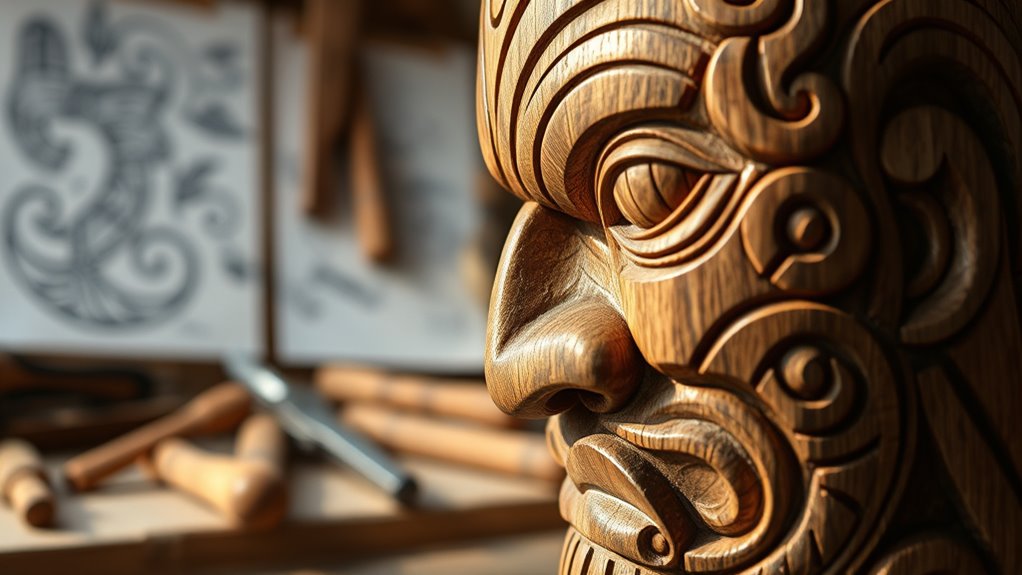
Legacy carvers like John Sheehan Snr and Paddy Cooper play a vital role in preserving New Zealand’s Māori jade carving traditions across generations. They guarantee the continuity of heritage by mastering traditional techniques and passing them down. Their work often involves sourcing rare pounamu locally, such as from Hokitika, emphasizing regional authenticity. These artisans create meaningful pieces like ceremonial adzes, pendants, and carvings filled with Māori spiritual symbolism. Many have established workshops and brands, like Mountain Jade, which promote Māori culture internationally. Their lifelong dedication keeps the cultural significance alive.
Their contributions include:
- Maintaining traditional carving methods.
- Sourcing authentic regional materials.
- Creating culturally symbolic artwork.
- Promoting Māori heritage globally.
- Regular assessment of their craft ensures the preservation of traditional techniques.
Innovation and Natural Inspiration in Modern Woodwork
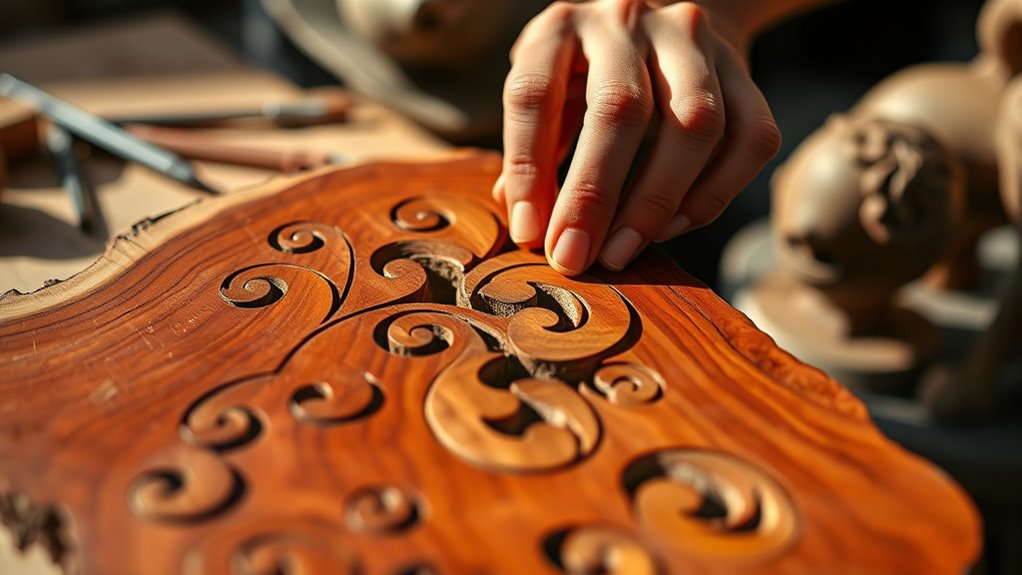
Modern New Zealand wood artists are transforming traditional Māori carving motifs and native timbers into innovative works that reflect both cultural heritage and contemporary design. These wood artists draw inspiration from New Zealand’s stunning landscapes—forests, mountains, and coastlines—shaping their organic forms and textures. They combine traditional hand carving with cutting-edge techniques like laser cutting, pyrography, and mixed media to produce striking, unique pieces. Many focus on environmental sustainability, sourcing locally felled or reclaimed wood to reduce ecological impact. Collaborations between indigenous Māori carvers and contemporary artists foster a vibrant exchange of traditional knowledge and modern innovation. As a result, these wood artists push creative boundaries, blending heritage with modernity, and continuously evolving New Zealand’s dynamic woodwork scene.
Highlighting Māori Artifacts and Sacred Carvings
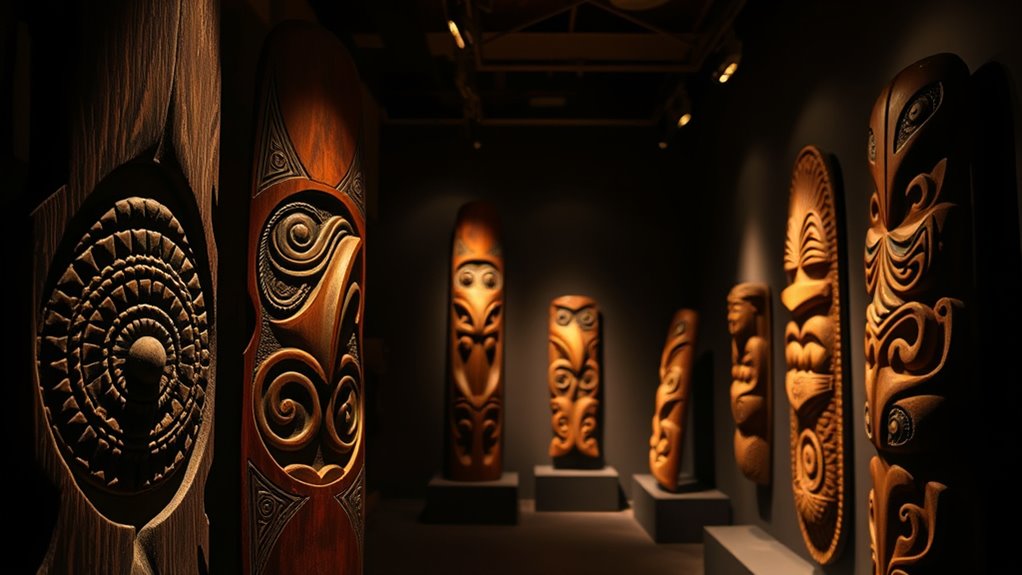
Māori artifacts and sacred carvings showcase a rich tradition of storytelling and spiritual symbolism through intricate wooden designs. You’ll find items like carved boxes, tiki pendants, and house lintels decorated with symbolic patterns and ancestral figures that embody Māori history and beliefs. Sacred carvings, such as those on wharenui (meeting houses), feature tā moko motifs and figures representing gods, ancestors, and spiritual beings. Traditional Māori wood carvings are crafted with tools like adzes and chisels, creating detailed patterns that hold cultural significance. These artifacts serve both practical and ceremonial roles, often depicting mythological themes and tribal stories. Key examples include:
- Carved house lintels and storehouses (pataka)
- Bone, ivory, and nephrite jade pendants
- Tiki ornaments
- Spiritually symbolic patterns and figures
Spotlight on Māori Woodcarver Broxh and His Unique Style

Broxh has carved out a unique space in the world of Māori wood art by blending traditional techniques with digital innovation. As a Māori woodcarver, he masterfully combines Whakairo Māori patterns and symbols with modern streaming platforms like Twitch, bringing cultural storytelling to new audiences. His large-scale, intricate carvings highlight his craftsmanship and generosity, often featuring Māori motifs that reflect heritage and mythology. Broxh’s use of authentic tools such as adzes and chisels demonstrates his commitment to traditional methods, even as he shares his process live online. This fusion of old and new allows you to experience Māori wood art firsthand, making it accessible worldwide. His innovative approach elevates Māori carving, inspiring both traditional practitioners and digital enthusiasts alike.
Frequently Asked Questions
Who Were the Famous Early New Zealand Landscape Artists?
You’re curious about the famous early New Zealand landscape artists. They include William Fox and Charles Heaphy, who captured the country’s dramatic scenery, and Gottfried Lindauer, known for Māori portraits and landscapes. Charles Decimus Barraud documented iconic sites like Auckland Harbour and volcanic cones. These artists used watercolor and oil to showcase New Zealand’s rugged wilderness, helping shape the nation’s visual identity and inspiring future generations.
Who Owns Mountain Jade?
You might wonder who owns Mountain Jade. It’s a family-run business, owned by the Sheehan family, started by John Sheehan Snr, a renowned jade carver. His wife Margaret also creates contemporary jade jewelry. They’ve built a strong legacy of craftsmanship, sourcing pounamu exclusively from New Zealand’s West Coast. Their commitment to regional authenticity keeps their ownership within the family, ensuring the brand’s heritage and quality continue.
What Is the Traditional Art of New Zealand?
They say “A picture is worth a thousand words,” but in New Zealand, traditional art tells stories through wood. You’ll find Māori carving techniques used for everything from ceremonial tools to canoes, rich with symbols like spirals and manaia figures. This art isn’t just decorative; it’s a living expression of identity, spirituality, and heritage, passed down through generations and woven into every carved piece, keeping culture alive.
What Is the New Zealand Traditional Carving?
You want to know about New Zealand’s traditional carving, or Whakairo Māori. This art involves creating intricate wood designs that often depict ancestors, spiritual symbols, and myth stories. Using tools like adzes and chisels, you craft bold geometric patterns, spirals, and natural elements. These carvings decorate important cultural objects like meeting houses and canoes, carrying deep spiritual meaning and respecting strict protocols passed down through generations.
Conclusion
As you explore New Zealand’s wood art scene, remember that each carving is more than wood—it’s a story, a heartbeat, a sacred echo of tradition. Like the river shaping its path, these artists carve their heritage into every piece, forging connections across generations. By embracing their craftsmanship, you become part of a timeless flow, where nature’s beauty and cultural spirit intertwine, guiding you toward a deeper understanding of Maori legacy and innovation.

